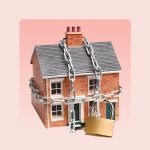Images by GettyImages; Illustration by Bankrate
You just found out that you’re getting a tax refund and are considering using it to make a lump-sum payment toward your credit card debt. Before you do, let’s make sure you are setting yourself up for long-term financial security — not just temporary debt relief.
With credit card interest rates hovering around 20 percent, it’s understandable to want to pay them off quickly. Seeing how much you lose to interest each month can be frustrating, especially when you imagine the savings, self-care and future stability you could be investing in with the money going to interest.
I want you to be debt-free, but I also want you to stay debt-free, and that starts with having systems in place before making big debt payments. So before using your tax refund to pay off high-interest debt, I’m going to share a few priorities you’ll want to have in place first.
Priority 1: Build a checking account buffer
A checking account buffer is your first line of defense against unexpected expenses. It should be 5 percent to 25 percent of your monthly expenses and sit untouched in your checking account. This habit builds awareness around depending and helps you assess whether to increase income or reduce expenses.
Example buffer
If your checking account buffer is $500 and your balance is $600, train yourself to think that only $100 is available to spend.
Priority 2: Save one month of expenses
Now, if you already have a checking account buffer in place, the next step is to make sure you also have at least one month of your expenses set aside. Ideally in a high-yield savings account.
This acts as a starter emergency fund that helps you prevent future debt. Often, our debt is simply a reflection of not having the cash reserves available when unexpected expenses arise.
By having at least one month of expenses set aside, you’re protecting yourself from falling back into debt when life happens. And keeping this money in a high-yield savings account ensures that it earns interest — a small reward for saving and being financially prepared.
Priority 3: Prepare for expected expenses (sinking funds)
Once your starter emergency fund is in place, think about upcoming expenses you already know are coming, like travel, weddings or holidays. These are perfect for sinking funds — savings set aside for planned expenses that can help you avoid debt.
Keep in mind:
By putting the money for your sinking funds in a high-yield savings account, you can spend with confidence without relying on debt and earn a little extra while you’re at it. You may still choose to put these purchases on a credit card to earn points, but the difference is that you’ll have the money in your savings account ready to pay it off in full.
Being financially prepared for the things you want to spend on allows you to spend with joy. It also makes your debt payoff plan more sustainable in the long run.
Priority 4: Make extra payments toward debt
This brings us back to the initial impulse — putting your tax return toward a high-interest debt. Because you’ve already established your financial safety nets, any remaining funds can go directly toward reducing what you owe.
To make the biggest long-term financial impact, you may want to focus on paying off the debt with the highest interest rate first. This approach helps you minimize the amount you pay in interest over time. Start by listing all your debts in order of interest rate and use your tax refund to make a bigger payment toward the one costing you the most.
How to use your tax refund to make progress toward each priority
Now that you’ve learned about the four financial priorities — your checking account buffer, emergency fund, sinking funds and high-interest debt — you might feel a little discouraged, especially if it seems like your tax refund isn’t enough to fully fund each one.
However, I want you to know that you can make meaningful progress by distributing your refund across multiple priorities.
For example, if you receive a $3,000 tax refund here’s one way to break it up:
- Checking account buffer: $500. If your monthly expenses are $5,000, a 10 percent buffer would be $500. Allocating $500 to your checking account buffer helps you avoid overdraft fees and gives you breathing room when timing expenses.
- Starter emergency fund: $1,000. While a full month of expenses might be $5,000, you don’t need to save it all right away. Putting $1,000 in a high-yield savings account to cover one month of essential expenses can become your starter emergency fund. This will protect you from relying on credit cards when unexpected costs come up.
- Sinking funds for expected expenses: $500. Set aside $500 for upcoming expenses like birthdays, travel or holidays. Having the money ready helps you spend guilt-free.
- High-interest debt: $1,000. Use the rest to make a lump-sum payment toward your high-interest debt, reducing how much you’ll pay in interest over time.
Money tip:
This is just one example of a balanced approach — and one that’s often more effective than putting your entire tax refund toward one single goal. You’re strengthening your financial foundation while still making real, measurable progress.
What to do if there’s still cash left over
If you still have money remaining after addressing your financial priorities, consider contributing to a Roth IRA to build long-term wealth. Prioritizing financial security before debt payoff helps break the debt cycle. With balance and intentionality, your tax refund can strengthen your overall financial wellness — not just today, but for the future too.
Read the full article here
















